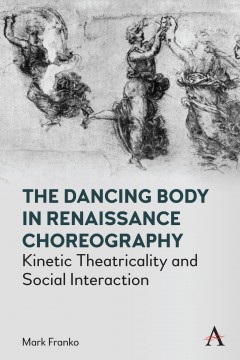The Dancing Body in Renaissance Choreography
Kinetic Theatricality and Social Interaction
By Mark Franko
Other Formats Available:
- About This Book
- Reviews
- Author Information
- Series
- Table of Contents
- Links
- Podcasts
About This Book
Renaissance dance treatises claim that the dance is a language but do not explain how or what dancing communicates. Since the body is the instrument of this hypothetical language, The Dancing Body in Renaissance Choreography problematizes the absence of the dancing body in treatises in order to reconstruct it through a series of intertextual readings triggered by Thoinot Arbeau’s definition of dance as a mute rhetoric in Orchesographie. This book shows that the oratorical model for Arbeau’s definition of the dance is epideictic and that although one cannot equate dance and oratorical action, the ends of oratorical action are those of dance: persuasion through charm and emotion.
The analysis of the rhetorical intertext opens the way to a sociological one. Through a reading of courtesy books as well as a chapter of Tuccaro’s L’Art de Sauter et Voltiger en l’air it is shown that dance and social behavior were not discontinuous in the Renaissance. Instructions for the body can be divided into the categories of the pose and movement. They are examined as a model for the most important and widely practiced dance of the Renaissance: the basse danse. The characteristic motion resides in an opposition as well as an interpenetration of stillness and mobility. This is developed through a reading of fifteenth-century dance theorists’ concept of misura and fantasmata. Stefano Guazzo’s La Civil Conversazione is used as a textual interpretant to ascertain the strategy of movement and the pose in the interaction between dancer and spectator.
Reviews
“Mark Franko’s intellectually challenging study of the history and language of dance treatises exposes a kinetic fashioning of the body. Franko’s new preface and judicious close readings offer an indispensable guide to early modern histories and theories of dance and movement, traversing fresh insight on gesture and rhetoric as well as madness and courtesy. From popular practice to preoccupations with movement and theatricality, this work’s careful translation of aesthetic terms and values illuminates dance treatises’ and manuals’ important role in the history and theory of dance embodiment. This book is a compelling introduction to these sources and expert contribution in pre-modern dance and performance research.” —V K Preston, Concordia University, Canada
“Franko presents dance as a signifying practice akin to literature, that calls for an interdisciplinary interpretation. The dancing body moves through texts, but also becomes itself a text, defying the elusiveness of corporeality in dance notation and constituting itself in the social world characterized by the fashioning of individual identity. It inscribes itself in its cultural context through its performative dimension.”—Sidia Fiorato, University of Verona, Italy
Author Information
Mark Franko is Laura H. Carnell Professor of Dance at the Boyer College of Music and Dance, Temple University, USA. He is founding editor of the Oxford Studies in Dance Theory book series.
Series
Anthem Studies in Theatre and Performance
Table of Contents
Preface to the Revised Edition; 1. Introduction; 2. The Mythological Intertext: Language; 3. The Sociological Intertext: Courtesy; 4. The Pedagogical Intertext: Precepts; 5. The Political Intertext: Civil Conversatione (Social Intercourse); Bibliography; Index.
Links
Stay Updated
Information
Latest Tweets



